|
|
|
|
This article honors Max Leslie, VB-3 leader, my great uncle, and all those who served in the War.
In the first month or two of 1942, Japanese were conquering Pacific fast. They succeeded in surprising American fleet at Pearl Harbor on December 7,1941, then Guam fell only three days later, followed by Wake on December 23, Singapore fell on February 15, 1942, and US Navy had no way of stopping them.
The key to all Japanese advances were their carrier forces, consisting of such ships as Akagi, Kaga, Soryu, Hiryu, Shokaku and Zuikaku. Their crews had good equipment and years of war experience.
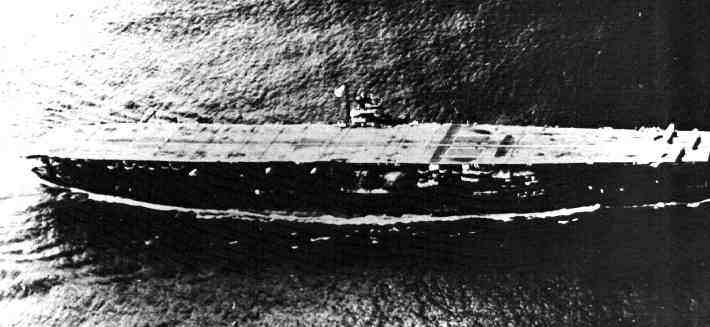
AKAGI (picture from 1927) (picture from 1927)

KAGA

In between January 11 and 14th Rear Admiral Ugaki, a chief of staff to Admiral Yamamoto, sketched the plans for the future advances. There he proposed an advance toward the Midway and Johnston islands after June of that year, and then further on to Hawaii. The plans for occupation of Midway were approved by the Naval General staff on April 3. The operation was called "Operation MI."
On May 27, 1942 the great armada sailed from the fleet anchorage at Hashirajima in the Inland Sea of Japan. That day was the Navy Day - anniversary of the great victory of Japan over Russia in the Battle of Tsushima, during the Russo-Japanese war. Japanese were confident that this sortie would end in sucess too. They knew that the weakened American fleet had only two carriers at hand (they thought that the USS Yorktown was sunk in the Coral Sea three weeks earlier), whose inexperienced pilots had no chance to win against their more numerous and more experienced foe.
Japanese First Carrier Striking Force consisted of four big
carriers, Akagi, Kaga, Soryu and Hiryu while Shokaku and Zuikaku
couldn't take part in the battle due to the damage sustained in the Coral Sea (see 'Battle
of the Coral sea'). These were under the command of VADM (Vice ADMiral) Chuichi Nagumo
(his flagship was Akagi). These four carriers were screened by RADM (Rear ADMiral)
Hirokai Abe's Support group consisting of battleships (BB) Haruna and Kirishima,
heavy cruisers (CA) Tone and Chikuma. Destroyer screen consisted of 11
destroyers (DD). This huge group was responsible of defeating defenses at Midway and
dealing with any American force that may try to interfere.
Behind them came the Japanese battleship force under the command of the Admoral Yamamoto
himself (C-in-C Japanese fleet), whose flagship was the biggest ship of that time,
battleship Yamato accompanied by battleships Nagato and Mutsu and
four CAs one CL (light cruiser) one CVL (light aircraft carrier), 8 DDs, and various
support vessels. This force would be responsible of protecting the ground troops once they
landed, once all aerial opposition was neutralized by Nagumo's carriers.
The only Japanese force that did not sail that day was the Northern Force under VADM Hosogaya which consisted of 26 ships including two light carriers Ryujo and Junyo. Their task was to attack the American bases in Northern Aleutian Island chain (Dutch Harbor in particular), in order to divert possible American counterstrike.
So, this was the composition of the Japanese fleet responsible for victory at Midway, the biggest fleet of that time. In the meantime, the American code breakers were working hard to break the Japanese naval code JN-25. Under the leadership of Commander Rochefort, codebreakers were able to read bits and pieces of the Japanese coded messages, and were able to read that the Japanese were going to make a great move to capture "AF" specifying that the move is going to be made around June 3. But what was "AF?" Admiral Nimitz (unlike other Admirals in the Navy) thought it was Midway, and he set a trap for the Japanese radio operators. He had a message flown to Midway to be transmitted saying in plain English (not coded) that the fresh water refinery had broken down. As it was expected Japanese took the bait. Japanese radio station intercepted Midway's message and sent another one saying that "AF was low on water." Now there was no doubt about the target. By May 25 Americans knew which ships and units will be involved in this operations, and Japanese had no idea that the US was reading its codes. But the US Navy had only limited nomber of ships to try and stop Japanese fleet. Only three carriers available USS Yorktown CV-5 (coming back from the Battle of the Coral Sea), USS Enterprise CV-6 and USS Hornet CV-8 (both coming back from the raid on Tokyo) were at sea and it was not known whether the Yorktown will be repaired in time to participate, after she suffered damage from one 1000-pound bomb in the Coral Sea. All three carriers were called to return to Pearl Harbor immediately.
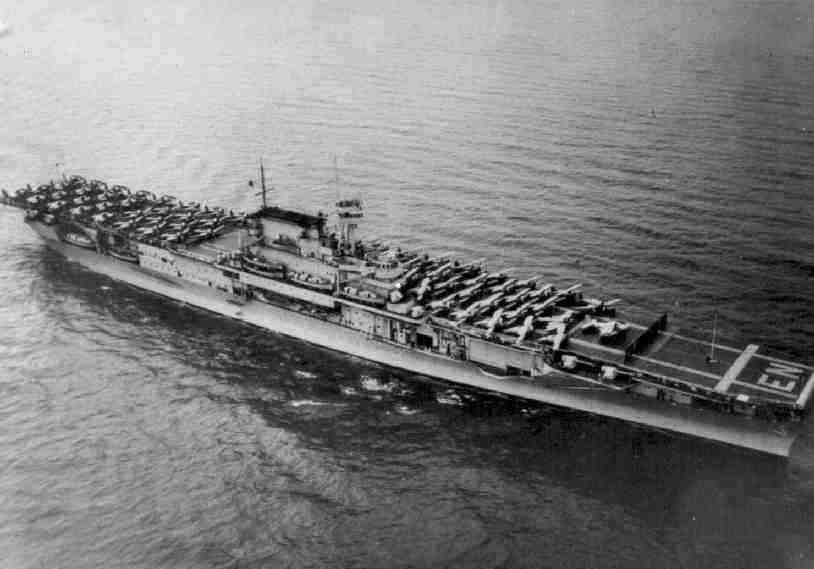
USS ENTERPRISE CV-6
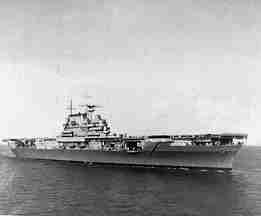
USS HORNET CV-8
The two carriers of the Task Force 16 (TF-16) came back on May 26, Enterprise moored to berth F-2 at 1158, while Hornet moored to berth F-10-S seven minutes later.
Nimitz wanted to give the full command to Admiral Halsey, but Halsey had to be hospitalized because of the skin erruption he was suffering from. So, the command of the American force went to Admiral Frank Jack Fletcher, commander of the TF-17 based around the Yorktown. Rear Admiral Raymond Spruance was to replace Halsey in command of the TF-16. On May 27, a ceremony was held aboard the Enterprise to award decorations to officers and men neatly lined up on the Enterprise's flight deck. That same day the USS Yorktown and her TF-17 returned to Pearl Harbor. Fletcher was summoned to Nimitz's office and introduced to the whole situation. The Yorktown was immediately put for repairs into Berth 16. It was estimated that the repairs would take three months. Nimitz gave them three days to prepare Yorktown for combat.
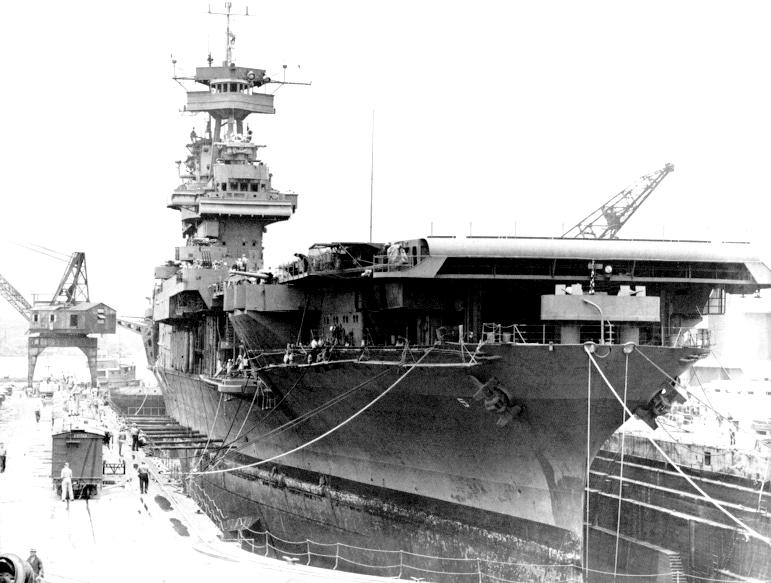
USS YORKTOWN under repairs on May 31, 1942 at Pearl Harbor under repairs on May 31, 1942 at Pearl Harbor
For three days Yorktown was full of workers trying to make
her ready for combat, but after that third day she was ready. The structural damage wasn't
the only problem. Yorktown's air group needed to be replaced too. The fighter
squadron VF-5 was merged with Saratoga's VF-3 named VF-3 and put under the
leadership of Lieutenant Commander John Thatch. Bombing squadron VB-5 was replaced again
with Saratoga's VB-3.
Task Force 16 sailed out on May 29. It was composed of two sister carriers Enterprise
(Capt. George D. Murray) and Hornet (Capt. Marc A. Mitscher - promoted to Rear
Admiral on May 31on the way to Midway) screened by heavy cruisers New Orleans,
Minneapolis, Northampton, Pensacola, light cruisers Atlanta and Vincennes
and 9 destroyers, under overall leadership of Admiral Spruance.
Task Force 17 sailed out a day later under the command of Admiral
Fletcher. It was based around the Enterprise's and Hornet's sister ship Yorktown
(Capt. Elliott Buckmaster). Screen was composed of heavy cruiser Portland, light
cruiser Astoria and 6 destroyers.
In the meantime, the defences on Midway were strenghtened. Navy flew the detachment of six
brand new planes TBF (later in the war better known as the 'Avenger'), a part of
Hornet's torpedo squadron VT-8, which missed Hornet by a day, and could not join the
rest of the sqadron. Marine fighter squadron, VMF-221 (20 F2A-3 and 7 F4F-3), dive-bombing
squadron, VMSB-241 (11 SB2U-3 and 16 SBD-2), army bombing squadron (4 B-26 and 19 B-17),
and reconnaisance squadron (32 PBY-5) were also there to defend this tiny island against
the mighty Japanese fleet. But the burden of defence lay in the three carriers of the US
Navy.
Diversion at Aleutians
On June 3, at 0243 the order to launch all planes was given on two carriers of Northern Force, Ryujo and Junyo. Twelve D3A (nicknamed Val) dive bombers and six A6M (Zero) fighters took off Junyo while Ryujo contributed 11 B5N (Kate) torpedo bombers and 6 Zeros. Lieutenant Yoshio Shiga, commander of Junyo's fighters led the flight. The flight itself was on the 'every plane for itself' basis. Fog made the ceiling 700 feet. At takeoff one of Ryujo's bombers fell into the sea, but the quick reaction of one destroyer from the carrier's screen saved the entire crew from the icy cold water.
Junyo's flight ran into the PBY flying boat. Fighters shot it down, but the flight turned back, aborting the mission. Ryujo's planes kept on going, led by Lt. Masayuki Yamagami. As soon as they came over the American base they were greeted with heavy AA fire, for radar had spotted them some distance away. The attack lasted for twenty minutes. Japanese managed to shoot up a tank farm, radio station and army barracks, killing twenty-five soldiers and sailors. In exchange they lost two bombers, while two other planes were damaged (one of them a fighter). One damaged Zero was forced to make an emergency landing, which cost its pilot his life, but the plane was pretty much repairable. It was found by an American search party five weeks later. Plane was sent to the US, repaired and flown by the highly interested Americans who found that this plane, a terror of Pacific skies had a major weakness: a very light armor protection.
Battle begins
While the Aleutians diversion was underway, the First Carrier Force
under Nagumo, was plagued by the bad weather and a lack of intelligence. A flying boat was
supposed to make a reconnaisance flight over the Pearl Harbor and see if US carriers were
there, but the submarine which was supposed to provide fuel for that plane had to stay
under water because of the presence of American seaplane carrier.
But Nagumo kept on going as planned.
June 4, 1942 was a day when four Japanese carriers of the First
Carrier Division would launch their planes on Midway. At exactly 0400 the order was given
for all pilots to man their planes. All planes were ready by 0430, and at that moment
floodlights bathed flight decks with light, and the first plane went down the flight deck.
Total of 108 planes took off as a part of the strike against Midway. Each of four carriers
contributed 9 fighters while the rest were bombers. As a protection against the possible
air attack nine planes were sent from Kaga while nine more were ready to take off
from Akagi if necessary. Eighteen planes to cover twenty-one vessels, four of them
carriers was indication of the self confidence with which Japanese approached thi battle
of Midway. Each carrier kept certain number of bombers as a part of the second strike
which would either go against Midway (if there was a need for the second strike) or be
ready to deal with American fleet, if it showed up.
In the same time 3 reconnaissance planes were sent to search for possible American
intervention force. One plane from cruiser Chikuma developed the engine trouble and
was launched with a 30 minute delay. At exact same time 10 SBD-3 planes from Yorktown's
VS-5 took off in search of Japanese carriers.
At Midway a division of six F4F-3 "Wildcat" fighters of VMF-221 was launched at 0400 as well as 11 PBY-5 flying boats of VP-44. The engines of other planes were warmed up, planes armed and ready to take off at moment's notice. It was decided to split 21 F2A-3 "Buffalo" and 7 F4F-3 fighters in two groups in case if Japanese strike from more than one direction. At 0500 the patrol fighters were called down to refuel. The landing accident left marines with only 3 Wildcats.
Then, at 0530 a report from one of the PBYs piloted by Lt. Howard Ady located Japanese carrier(s) bearing 320 at a distance of 180 miles. Ten minutes later another report came in, this time from PBY piloted by Lt. William Chase. He sent out a famous report "Many planes heading Midway." At 0552, Lt. Chase stumbled upon the Nagumo Force and sent out a report saying that he sighted "two carriers and main body ships..." A minute after this report was received, a radar station at Midway picked up a contact 93 miles out at 310 degrees, altitude 11,000 feet. All fighters were scrambled immediately, followed by B-26s and TBFs at 0600.
"Hawks at Angels Twelve"
Japanese approach was the simplest they could make. They were flying
in formation at 11,000 to 12,000 feet and were all in one group. Division of three
Wildcats under the Lt. Carey spotted them at 0612. He spied them at first, and then he
grabbed his radio receiver and said:
"Hawks at Angels Twelve!" (meaning that enemy bombers are at 12,000 feet).
Battle started some 40 miles away from Midway. Carey dived on its prey, aiming at
the leading plane. He pressed his attack until his target exploded. A rear seat gunner of
one plane raked Carey's plane with machine gun bullets, smashing steel in both Carey's
legs. Carey's wingman, Lt. Canfield also shot down a plane, but he had to run away when
Japanese Zeros turned toward him. He retreated into a cloud, and stayed there for some
time. Then he joined Carey on the way back to Midway. Carey was in severe pain, and he
nearly passed out on the way back. Canfield landed first followed by Carey. Carey could
not move his legs and thus could not control the rudder pedals. His plane slid off the
runway and buried its nose into the sand beside it. Two men pulled him out and right into
the trench just as the first bombs started falling down.
Meanwhile, other units engaged enemy flight. Captain Carl and his division charged right into one formation. Carl turned back to see the results, but instead found several unfriendly Zeros on his tail. He managed to get away and shoot down one plane before landing. Major Parks never came back, nor did any other plane of his division. Very few fighters survived. Fourteen out of 26 pilots were killed, many were wounded, and only two planes were fit to fly again. The defense of Midway was now in the hands of gunners.
Attack lasted from 0630 to 0643 during which every building became a target, even the Navy dispensary, clearly marked with a red cross. All hangars were hit, Post Exchange, Navy laundry building,... After the bombers dropped their eggs, fighters took upon them the job of strafing the ground targets. At 0643 it was all over. Lieutenant Tomonaga, the leader of Japanese flight assesed the damage inflicted and called for the second strike.
Counterattack from Midway
As it was mentioned, as soon as the Japanese flight was picked up (0600), all bombers were sent to attack the enemy carriers (five flights in total). First to take off were six TBFs of VT-8's detachment under the leadership of Lt. Langdon Fieberling, followed by four B-26 bombers under Captain James Collins, Jr. Midway instructed them to "attack enemy carriers bearing 320 degrees, distance 180, course 135 degrees, speed 25 knots."
They reached the target area by 0710. Japanese fleet covered the whole horizon. Akagi was the first to see the unwelcome guests at 0705. Nagumo sent 10 Zeros to intercept them, while the ships of the screen opened fire.
TBFs opened their bomb bay doors (just in case if they have hydraulics failure). Five of them were shot down easily. Sixth, piloted by Lt. Earnest was the only survivor. Earnest's rear gunner was killed almost as soon as the action started, and Earnest himself was hit in the neck, and was bleeding horrendously. His elevator was useless, his gunner was dead, radio operator knocked unconscious, and he was wounded. He had no hope of reaching the carriers, so he dropped a torpedo on a cruiser. Torpedo never hit. Earnest managed to get out, with his electrical system out, hydraulic system gone, he could not close the bombbay doors, he had no compass reading, and in fact, the engine and himself were the only thing still working. Navigating by guess, he managed to get to Midway. His radio operator, Ferrier, regained consciousness in the meantime. They touched down at 0940, the sole survivors of the whole detachment.
Meanwhile, the B-26s attacked. Turning slightly to port and then sharply to starboard, to avoid AA fire, they went after Akagi. Two planes were shot down. Collins released his torpedo 800 yards away, while the plane flown by Lt. Muri released at 450 yards. Muri's plane had taken a considerable punishment. Several hundred bullets hit the bomber, but Muri managed to get away. No torpedoes hit, even though Army pilots claimed they did.
At about this time Nagumo got Tomonaga's message asking for the second strike. He still had no indication of the presence of any American surface force. Thus, he ordered all planes from the second strike to be armed with bombs to attack Midway.
Situation abruptly changed at 0728 when the scout plane from cruiser Tone spotted American fleet and reported: "Sight what appears to be 10 enemy surface ships, in position 10 degrees, distance 240 miles from Midway. Course 150 degrees, speed over 20 knots." What this plane did not report were the ship types. If there were no carriers, they could attack Midway first and then deal with them. But if not...Nagumo orders torpedoes left on the planes that were not changed yet, for the purpose of attacking the US fleet. Two minutes later he radioed the scout plane asking for ship types. While the Japanese were changing bombs for torpedoes, at 0748 Midway's divebombers under the leadership of Major Henderson appeared. These were 16 SBD-2 "Dauntless" planes which took off at the same time as TBFs and B-26s from Midway (at around 0610), and were also directed by Midway station to attack Japanese carriers.
Henderson's planes ran into Soryu's fighters as soon as they caught glimpse of the enemy carriers. Henderson's plane was shot down immediately, so Captain Elmer Glidden took the lead, breaking out at about 2,000 feet almost directly over the Hiryu. He began his dive, followed by others at 5 second intervals. Pulling out of the dive Glidden thought he saw couple of hits, but actually, they all missed. The best they did was to completely ring the carrier with bombs, throwing geysers of water all around it. In the meantime Lt. Daniel Iverson attacked a carrier which had escaped all attention of his squadron mates. He dived towards it and released the bomb which fell some 50 yards off the Kaga's stern. As soon as he pulled out of the dive, he was attacked by Zeros, which "hit him couple of times" (a major piece of understatement, for after he landed back, he counted 210 holes in the fuselage!). Marines credited themselves with three direct hits and several near misses an a Kaga class carrier, while in fact the scored no hits. Eight out of sixteen planes were lost in this action.
At 0758 another message was received from the scout tracking the American fleet. This time he reported a drastic change in the course of the enemy (Japanese should have known that these ships were turning into the wind, and that there were carriers present in that group!). Few minutes later another message reached Nagumo from this plane saying that the enemy force is composed of 5 cruisers and 5 destroyers. And again, for the third time in an hour, Nagumo ordered bombs loaded on the planes, instead of the torpedoes.
Then at 0806 Chikuma caught sight of another group of planes coming in. These were again planes from Midway, this time the famous B-17s, the "Flying Fortresses" under the leadership of Lt. Col. Walter Sweeney. His planes dropped bombs from the altitude of 20,000 feet, scoring no hits. Japanese did not even try to attack these planes, for if they were as tough as it was reported, it would have been useless.
As this attack was underway, yet another group attacked. This time it was a group of 12 SB2U-3 dive-bombers under the leadreship of Major Benjamin Norris. These slow and lightly armoured planes were an easy prey for Zeros. It is surprising that only two planes were lost to Zeros, while two more had to ditch for the lack of fuel.
This was the last attack from Midway that morning. No Japanese ships were even scratched!
As the last attack was underway a periscope broke the surface right in the middle of the Japanese fleet. It was the periscope of the USS Nautilus under the command of Lt. Cdr. William H. Brockman, Jr. A battleship on his port bow started shooting his main battery at his periscope, for which Brockman retaliated by a torpedo, which the battleship dodged. Then he took his sub down to escape a depth charging attack that the Japanese destroyer Arashi was about to deliver. It was going to last for some 45 minutes.
Now, we are going back to Akagi's bridge where Admiral Nagumo received another message from Tone's scout plane, at 0820. This time it jolted everyone present:
"The enemy is accompanied by what appears to be a carrier..." All the staff on the bridge was shocked. Now Nagumo, again ordered bombs to be exchanged for torpedoes, wanting to attack the US fleet. But he could not launch them before he recovered the planes that were coming back from the attack on Midway, or else they would all have to ditch. He had 18 torpedo planes from Akagi, 27 from the Kaga, 36 divebombers from Hiryu and Soryu, and 12 Zeros from all four ships, ready to be launched as soon as the Midway strike was recovered.
In all this confusion, another message came from the screening ships, saying that 10 enemy planes are coming in. But these planes did not come from Midway!
Yorktown, Enterprise and Hornet strike
Midway defenders didn't know that the US carriers were going to be there. They were told that they were needed for the defense of Hawaii, and that they were on their own (it was said for the security reasons). But they were there, waiting!
The first confirmation that the enemy carriers were sighted was
received at 0534 on the bridge of the Enterprise. At 0553 Enterprise picked
up another transmission which said that the planes are heading towards Midway.
Unfortunately this message gave no clue as to the number of carriers sighted. But, they
had the position of the enemy carriers, and they were determined to hit Japanese with
everything they had. It was mentioned that Fletcher launched 10 SBDs of Yorktown's
VS-5 at 0430, to search for the enemy fleet. So, the Yorktown had to continue on
the same course until these planes returned. Fletcher signaled Spruance at 0607 to turn
into the wind and launch everything he had. Spruance had originally planned to start
launching at 0900, when the enemy carriers would be some 100 miles away, but in the next
half hour he realised that he had no time to wait, because the Midway was under attack
then. If he wanted to inflict the maximum damage, he had to launch immediately.
He consulted Miles Browning, his chief of staff, and decided to launch immediately,
because Nagumo would have to hold the course until he recovers all planes from the Midway
strike (they estimated time of recovery at around 0900). The order was given to launch
immediately, starting at 0700.
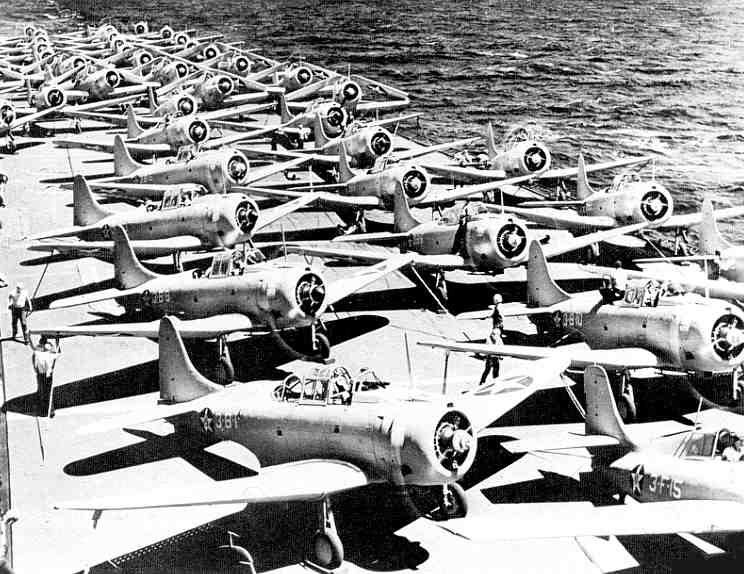
Flight deck of the USS YORKTOWN
on the morning of June 4
just before the attack on the Japanese carriers. These are SBD-3 planes of VS-3
USS Enterprise launched 10 F4F-4 Wildcat fighters of VF-6, under the Lt. James S. Gray, 33 SBD "Dauntless" dive-bombers of VB-6 (led by Lt. Richard Best) and VS-6 (led by Lt. Wilmer Gallaher) and 14 TBD-1 torpedo bombers of VT-6 led by Lt. Cdr. Eugene Lidsey. Overall leadership of Enterprise's planes belonged to Lt. Cdr. Clarence W. McClusky, flying in SBD.
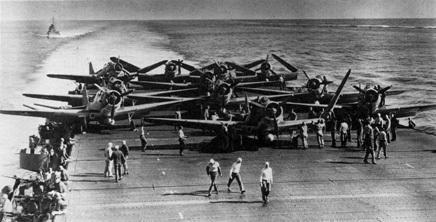
VT-6 is being launched from the deck of the USS
ENTERPRISE.
Only four out of fourteen planes from that squadron came back
USS Hornet launched 10 Wildcats of VF-8 (Lt. Cdr. Samuel Mitchell), 35 SBDs of VB-8 (Lt. Cdr. Robert Mitchell) and VS-8 (Lt. Cdr. Walter Rodee), and 15 TBDs of VT-8 (Lt. Cdr. John Waldron). Overall leadership belonged to Cdr. Stanhope Ring flying in SBD. USS Yorktown had to delay the launching of its air group until they recovered 10 planes of VS-5, and launched (beginning at 0845) 12 TBDs of VT-3 (Lt. Cdr. Lance Massey), 6 F4F-4s (Lt. Cdr. John Thatch) of VF-3 and 17 SBD-3s of VB-3 (Lt. Cdr. Maxwell Leslie). Planes of VS-5 were not launched into the attack.
Complications prononged the launching of the Enterprise and Hornet planes, and Spruance could not keep planes that were already in the air circling above the carriers and waiting for other planes to take off and form on, because they were waisting fuel, so he sent them off. As Enterprise's VB-6 and VS-6 left, Lt. Jim Gray and his VF-6 were taking off. Torpedo bombers of VT-6 were next, leaving at 0806.
On Hornet, John Waldron and his VT-8 were leaving at about the same time. In his group, Flying the plane with marking 8-T-14 (fourteenth plane of VT-8) was Ens. George Gay. This was the first time he took off the carrier with a torpedo. Whatsoever, he had never seen it done! Don't get the impresion that this opeartion was coordinated. Neither Air Group knew what the other one was going to do. Enterprise bombers were going first, while fighters and torpedo bombers were chasing after them.
Torpedo bombers attack
VT-6 and VT-8 were now going separately, but close to each other, their courses differed by only few degrees. Lindsey and his VT-6 were followin the prescribed course of 240 degrees, while Waldron and his VT-8 were following a more westerly course, John Waldron following his intuition rather than calculations which took him straight to the Japanese fleet!
Jim Gray, leading VF-6 had a job of protecting both VT-6 and dive bombers of VB-6 and VS-6. Since the former flew low and latter flew high, it was decided to have fighters fly high, for it was much easier to dive down and help torpedo bombers than to climb up and protect dive bombers. If Torpedo 6 ever got in trouble, Lindsey would call over the radio "Come on down, Jim" which would send fighters diving to help VT-6. But a mishap happened on the way. Jim Gray mistaked VT-8 for VT-6 and went following them instead of VT-6. High above the clouds VS-8 and VB-8 flying together overtook Waldron's squadron, and continued on to the southwest. The rendezvous had failed. Soon afterward, Waldron noticed Japanese fleet on the horizon, and started his attack run all alone. Gray and his VF-6 lost the Torpedo 8 due to the cloud cover. Fifteen planes had no fighter protection, but still they came in, at 0918. Outnumbered by Zeros, they stood no chance. One by one, the TBDs were all chopped up to pieces. Waldron directed his flight towards the Japanese carriers, but then, he was gone too. When George Gay, flying the last plane in the section, looked around he saw two other TBDs of his squadron, which were soon both picked out. Gay was now all alone. His gunner was wounded, so was Gay. More and more bullets hit his vunerable plane, but Gay was finally close to its target: carrier Kaga. He launched his torpedo, and zoomed right over the Kaga, seeing "the little Jap captain jumping up and down raising hell." He tried to shoot at them with his machine guns, but there was no response from them when he pulled the trigger. Zeros were still on his tail. Overwhelmed, his plane fell into the ocean. The fifteenth and last plane of VT-8 was gone. Gay managed to get out of the plane before it sank. Fifteen planes, thirty pilots and gunners, and only one survivor! He was pulled out a day later.
In the meantime, Torpedo 6 continued without fighters (they didn't know it at the time), flying at 1,500 feet. Lindsey caught the first glimpse of Japanese at 0920 (soon after Waldron attacked), and went into the attack at 0931. Picking the closest carrier as his target, Lindsey split his 14 plane squadron in two divisions, to hit the carrier from both sides. It took him 20 minutes to reach the carrier while the Zeros were chopping them up. They never reached a decent launching position, and at 0958 the remaining planes started attack runs. Lt. Ed Laub released his torpedo some 500-800 yards out, three other TBDs doing the same thing. All four missed the target; ten other planes were gone. The signal "Come on down Jim" was never sent, for Lindsey was the first one shot down.
In the meantime Jim Gray came to the scene. Through the holes in the overcast he saw some torpedo squadron making the run on the Japanese carrier, jumped by the fighters. It was too late to do anything for that squadron. At 1005 he took his squadron back to the Enterprise.
Yorktown's torpedo squadron, VT-3, arrived at the scene at 1000 just as the VT-6 ended its attack. At the time Japanese carriers were 30-40 miles away. Just like other two torpedo squadrons, they had no fighter protection (it would arrive later, but too late to be of any help), but they kept coming in. First two Zeros ripped into the formation when they were some 14 miles away. Then more Zeroes arrived. After Massey was shot down, it was up to pilot Esders to lead the attack. Everywhere he'd look, he could see planes falling down from the sky. There was only one other plane left with him, that of Lt. Corl. They released torpedoes, but missed, and started their trip back to the Yorktown.
Attacks of carrier torpedo planes ended in a disaster. Thirty-five
(10 out of 12 from VT-3, 10 out of 14 from VT-6 and 15 out of 15 from VT-8) were shot
down. The six survivors were in no shape to fly. They inflicted no damage to the Japanese
in turn for their losses. But they drew all Japanese fighters down to the sea level, and
left the skies above them clear for the dive bombers that were coming in at that moment.
It was 1026.
Planes from the Midway strike were recovered by 0918 (time when VT-8 attacked), and the
whole Japanese fleet changed its course to 070 degrees to close in with the American
fleet. The planes from the second wave were readied for attack on the US fleet. Planes
were brought from hangars to the flight deck, fully fueled and armed. The bombs that were
taken off were not returned to the bomb storage aboard the four Japanese carriers, and
were left lying all over the hangar deck. A great fire hazard!
These planes could not be launched while the American attack was underway. To make matters worse the submarine Nautilus was around, and the destroyer Arashi stayed behind the Japanese fleet to depth charge her. Arashi's attack was over by 0930, when her captain turned her around, and with full speed went after its fleet. Nautilus survived.
Dive bombers attack
Lt. Cdr. McClusky led 33 SBDs of VB-6 and VS-6 along the prescribed course until 0930. He was at the exact spot where the whole Japanese fleet should have been, 142 miles from the Enterprise, but there was no one in sight (note that the Japanese fleet changed the course in the meantime). Nothing but the ocean. The change in the texture of the sea to the left indicated that the coral reefs of Midway were just behind the horizon. But where were the Japanese carriers? He looked at his fuel gauge. He had less than half left. He had to decide fast what was he going to do. He made a right decision, which decided the outcome of the whole battle and turned the tide of the whole war in the Pacific. He decided to go out, extra 35 miles on the course 240 degrees, then turn northwest parallel to the anticipated Japanese route. At 0955, some 7 minutes after he turned into the new course, he spotted a wake of a lone ship below him, and decided to follow him. It was Arashi, a destroyer that stayed behind to deal with Nautilus. At 1005 they had the First Carrier Force in sight.
There was no fighter protection over the enemy carriers (remember,
they were low, still dealing with the torpedo bombers). Flying at 20,000 feet McClusky
decided to lead the Gallaher's VB-6 whose planes were armed with 1,000-pound bombs, and he
instructed Lt. Best, the leader of VS-6 whose planes had 500-pound bombs (they were first
to take off, so they did not have a deck space long enough to take off with 1,000 pound
bombs) to hit the carrier to port (which was Akagi). He led VB-6 over Kaga.
Somehow, Best missed the instructions, and assumed that Kaga was his target (it was
closer than Akagi and Best was behind Gallaher's squadron). Best split his division
in three to hit the enemy carrier from different directions, and prevent concentration of
her AA fire. At the time Best's VS-6 was 5,000 feet below McClusky and Gallaher. Just as
he was about to commence his attack, McClusky plunged past him like a kingfisher. Best
broke off his dive and took off toward Akagi.
The time was 1022.
Japanese were totally surprised when the lookouts spotted enemy dive bombers. McClusky's unit was in its dive. It was too late for Japanese to do anything now. nThey released their bombs from 1,800 to 2,500 feet. The first three bombs missed. Fourth bomb hit, and in an instant turned the whole flight deck into a holocaust! Full of armed and fueled planes, the flight deck of the Kaga burst into flames. The next two bombs missed, seventh and eighth bombs struck near each other, near the forward elevator, penetrating it and exploding in the hangar, with more fueled and armed planes, ready to be lifted up to the flight deck. Fire erupted instantaneously. Kaga was in mortal danger. It was completely on fire, all power was cut off, the whole bridge was wiped out, and there was no hope of containing the fires.
While this attack was in progress, Best took his men down to Akagi. As Best looked through the telescope sight of his SBD, he saw a plane taking off the deck. He released at 2,500 feet and was sure that the bomb could not miss. It was a near miss. The second bomb scored a direct hit near the amidship elevator, and exploding in the hangar. The next bomb had the most devastating effects. As with Kaga, Akagi's planes were also on the deck, ready to be flown against the US fleet. These two bombs started the chain reaction of explosion that sealed the fate of this carrier too. Radio room and antenna had been destroyed, fires were getting out of control, and the flooding had also been reported. Admiral Nagumo transferred his command from Akagi to the cruiser Nagara.
But the ill-fated attacks by the Devastators have not been in vain
for they succeed in breaking up the Japanese formation and bringing down its fighter
umbrella leaving the sky clear at precisely the moment thirty-seven of the peerless
Dauntless dive bombers arrive on the scene led by Lieutenant Commander Clarence McClusky
from that favorite of the Fates, the USS Enterprise. In six minutes they change the course
of the Pacific war. Like the Devastators, McClusky has no fighter protection. He has been
flying for an hour and a half and has seen only empty ocean. His fuel supply is running
low but he has decided to continue the search. A half an hour before he had spied a
Japanese destroyer racing northeastward like a bat out of hell and decided to follow it.
At almost the same moment, Lieutenant James Gray, leading a fighter squadron, broke radio
silence to report he had found the Japanese carriers. This gave Spruance and Fletcher
their first hard news about the main enemy fleet.
Now McClusky hears the voice of Miles Browning bellowing, "Attack! Attack!" over
the radio phone. McClusky replies, "God damn it, I will as soon as I find the
bastards!" He does and soon. McClusky leads half his Dauntlesses down on the carrier
Kaga while Lieutenant (J.G.) Earl Gallaher takes the other half hurtling down on the
carrier Akagi. The Akagi, Nagumo's flagship, takes hits from two one thousand pound bombs,
one on the flight deck causing huge explosions amid forty refueling planes, the other
bores into the hangar below causing the torpedo magazine to blow up. For the rest of the
day the Japanese mount a desperate effort to save the ship but at 7:15 that evening they
are forced to abandon her. Meanwhile the Kaga is hit four times, turning the carrier into
an inferno within seconds. It is now that seventeen Dauntlesses from the Yorktown, led by Max Leslie, join the fight and scream down on the
carrier Soryu, leaving her a crippled wreck. Later that evening the submarine
Nautilus, despite heavy depth charging by Japanese destroyers, pumps three torpedoes into
the Soryu and finishes her off.
The shaken Nagumo has been forced to transfer his flag to the cruiser Agar where later on
he has the small satisfaction of hearing the American carrier Yorktown has been found and
sunk. But while the Japanese bombers are breaking through the Yorktown's AA defenses,
twenty-four Dauntlesses, led by the formidable Gallaher, find the lone remaining Japanese
carrier, the Hiryu, fall upon her and send her to the bottom.
In the end Midway is an American victory of titanic dimensions. In one fell swoop the
Japanese have lost the initiative in the Pacific, never to regain it. From this moment on
it is the Americans who will call the tune. The United States Navy has paid the first
installment back to the Japanese for the debt of Pearl Harbor.
Book: Wings of War: Fighting World War II in the Air by Jeffrey L. Ethell
As incredible as it may sound, at the exact moment as the attacks on Akagi and Kaga were underway, another group of planes paid their respect to the carrier Soryu. It was Yorktown's VB-3 which was launched an hour later. During this delay, Fletcher and his staff put this time to a good use and estimated that as soon as the planes from the Midway strike were recovered, Nagumo would change the course. So, Yorktown's planes were given a different set of instructions which took them straight to the Japanese carriers. Yorktown's group had only 17 SBDs, and soon after the take off, Max Leslie, VB-3 leader, gave the order to arm the bombs. Due to a bug in the arming mechanism 4 planes dropped their bombs to sea. All of a sudden there were only 13 planes fit to attack. They took off at 0900, together with planes of VT-3 and VF-3. They spotted the First Carrier division at 1005 (the same time as Enterprise's dive bombers). To the westward, Leslie saw a carrier with the superstructure on the port side (Hiryu), still busy dodging planes of VT-3. Thinking that this group was VS-5 under the command of Lt. Wallace Short, he told him to hit the carrier to westward (only later he found out that VS-5 never took off the Yorktown). Leslie's wingman called him and said that his target was launching planes. So, Leslie started his dive towards Soryu. Thirteen planes scored 5 direct hits and three very near misses. Soryu suffered the greater damage than Akagi or Kaga. All three carriers were burning like hell, their fates sealed. Fires were raging everywhere on Soryu, crewmembers trapped belowdecks. At 1055 Capt. Yanagimoto ordered "abandon ship."
Now, let's see what happened to Hornet's dive bombers. When Stan Ring reached the anticipated point of interception, and found nothing, he continued extra 50 miles on the same course. The fuel gauges in the planes of his group dropped alarmingly low. So, Ring took with him 17 planes of VS-8 and 3 of VB-8 and returned to Hornet, while the remaining 13 dive bombers under Cdr. Johnson headed for Midway. They jettisoned their bombs in the lagoon as a friendly gesture, but the gunners on Midway didn't take it in that spirit, so they had to dodge aa fire, until they were recognized as friendlies. They took no part in the action that morning.
In only three minutes, these three squadrons, VB-6, VS-6 and VS-3, sealed the fates of three Japanese fleet carriers, and turned the tide of the whole war!
Japanese counterattack
As the planes of VB-3, VS-6 and VB-6 headed home, they left behind them three Japanese carriers afire, beyond hope. Akagi, Kaga and Soryu, all three the prides of Japanese navy, Pearl Harbor veterans were reduced to burning wrecks in only three minutes! But the fourth Japanese carrier, the Hiryu was not damaged. Her planes were ready, and at 1054 the first plane took off. The strike consisted of 18 dive bombers and 6 Zeros. There were no torpedo bombers, because there was no time to put torpedoes on the planes that returned from Midway strike. This small force found the American carriers by following American planes that were returning home.
Yorktown's planes were over their carrier by 1115. They were waiting for VF-3 to land first, orbiting over the carrier. In the meantime, Fletcher sent 10 of the 17 planes from VS-5 to look for the fourth carrier (not knowing that Hiryu was exactly where other three carriers were). VF-3 began landing at 1145, and at 1152 an air raid alarm went off.
Yorktown's radar picked up a large group of planes 32 miles away and closing. The screening destroyers moved in close. The cruisers Astoria and Portland stood off to starboard, in between the Yorktown and incoming intruders. Yorktown turned southeast, showing her stern to the attackers, and crancked up her speed from 25 to 30.5 knots. Fuel lines were drained and filled with carbon dioxide. All guns were manned, pointing west where the attack was going to come from. Combat Air Patrol (CAP) of 12 Wildcats was vectored to intercept the bogeys. The dogfight broke out some 20 miles away from the Yorktown. People on the Yorktown could see the smoke trails and fireballs in the distance, marking the end of a Japanese plane - or American. Captain Buckmaster moved into position ready to start giving orders for sharp evasive turns, to throw off the aim of the enemy dive bomber pilots. Yorktown's dive bombers were still circling the carrier, waiting for their turn to land, when they were told to go and land on the Enterprise or Hornet. Only eight planes of the original 24 managed to get to the Yorktown. Yorktown and the ships of the screen were throwing an enormous amount of AA fire into the sky as the dive bombers began their runs. A burst of fire got one before he started his dive. The leader was chopped up to pieces, but he managed to release the bomb which hit the flight deck aft of the island. It killed 19 otu of 20 men manning the 1.1'' quadruple mount. As it ripped through the deck, it set three planes in the hangar afire. The fire was quickly brought under control. The second bomb penetrated three decks and exploded in the uptakes of the stack deep inside the ship. This bomb caused the most damage. Yorktown's speed fell down to 6 knots. The third and final hit was scored on the forward elevator lighting fires in the rag stowage space, which was next to the 5'' magazines. Fires were brought under control.
As the attackers pulled out of the dives, destroyers and cruisers blazed away at them with everything they had. Very few Japanese planes came out alive. Some 20 miles away were Enterprise and Hornet were watching the sky in the distance filled with gun bursts. Then a heavy column of smoke rose, indicating that the Yorktown was hurt. Her two sister ships sent cruisers Pensacola and Vincennes from their own screen, as well as destroyers Benham and Balch. Some fighters were sent as well, but too late to help.
At 1216 (15 minutes after it started) the attack was over.
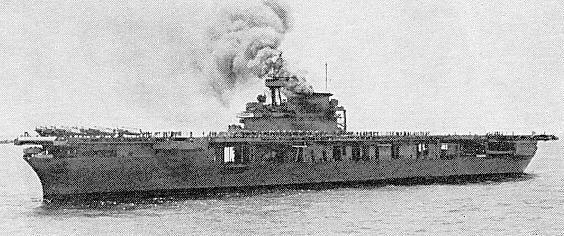
Smoke rises over the damaged YORKTOWN after the first attack
In the meantime, Hiryu prepared another strike consisting of 10 torpedo planes and 6 fighters. Only 6 planes from the first strike survived. They radioed that the enemy carrier is burning and that there are two more carriers present. The second strike was sent at 1245. While Hiryu was trying to turn the tide of the battle, Akagi, Kaga and Soryu were losing their battle for life, flooding, and fires raging.
Repairs on the Yorktown were underway as soon as the last Japanese bomber left te scene. Her radio was out, so Admiral Fletcher transferred his flag to cruiser Astoria. Yorktown's engines had to be brought to a full stop in order to repair the damage. By 1402 Yorktown regained her speed - 5 knots only. Then at 1410 the second flight of Japanese planes registered on American radars (the one sent from Hiryu at 1245). At 1418 speed was brought to 8 knots, then 10, 12, ... 15 knots by 1428. Now Japanese planes were only 37 miles away. Some 10 miles away, Wildcats from Yorktown's CAP tore into the enemy formation, tangling with 6 Zeros. At 1440 the screening ships opened fire. Some torpedo bomberd got through and launched torpedoes at the Yorktown. Capt. Elliott Buckmaster had only 19 knots available to avoid a 42 knot torpedoes launched from both bows.
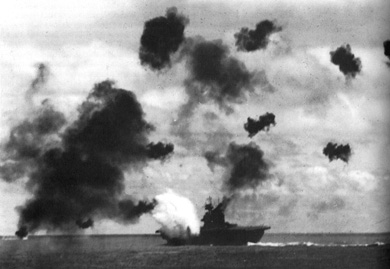
YORKTOWN hit by a torpedo at 1442 hit by a torpedo at 1442
He managed to dodge two, but at 1442 the first torpedo hit in the port side, quickly followed by another at the same place. Ship developed a 6 degree list, that increased to 17 degrees, while the rudder was jammed 15 degrees to port. The attack ended at 1452. Yorktown came to a stand still, listing 26 degrees to port.
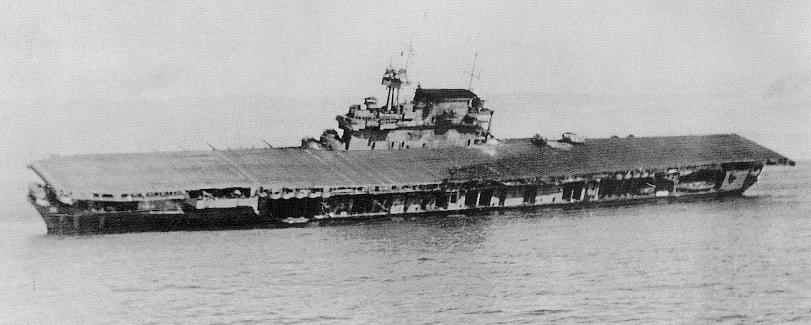
USS YORKTOWN
listing 26 degrees to port after two torpedo hits in the port side after the second
attack
All the power was gone, and thus the hope that she may be saved. Not wanting to risk the crew, Capt. Buckmaster ordered "Abandon ship" at 1455. Screening destroyers moved in to rescue the crew, and fished everyone out. Captain was the last man off the ship, after he made sure there was no one left behind.
While the Yorktown drama was unfolding planes of VS-5 made
contact with Hiryu, and reported her position to Enterprise and Hornet.
All the planes that were capable of flying were armed and fueled. At 1530 Enterprise
turned into the wind and commenced launching 24 SBDs under Gallaher's leadership to strike
Hiryu. As this was going on at 1527 a group of 11 SBDs approached Hornet.
These were planes that missed action that morning and went landed at Midway, refueled and
came back. They were armed and sent to get Hiryu at 1603. It was a bad day for
Hornet who lost all torpedo bombers, whose fighters had to ditch as they ran out of fuel,
and whose bombers missed the action that morning, but the return of 11 SBDs that were
considered lost forever, turned gloom to joy.
Fletcher now gave Spruance the full command of the two Task Forces.
This time they were easy to find. Gallaher spotted Hiryu at 1645 some 30 miles away, and were over her by 1658. Japanese were preparing the third attack at that time, destined never to take off. Gallaher led Enterprise's planes to strike Hiryu, and instructed Wallace Short and his VS-5 to attack a nearby battleship. Hiryu's captain managed to throw off their aim. Seeing them miss, Short led his squadron away from the battleship and hit Hiryu instead together with Enterprise's planes. Four hits were scored in a quick sucession. Hiryu met the same fate as the other three carriers of the First Carrier Force, burning and sinking. Japanese had had enough. Admiral Yamamoto ordered a retreat.
Soryu sank that night at 1915, Kaga 10 minutes later. Akagi was scuttled the following morning (June 5) at 0500, while Hiryu sank at 0900. All four carriers took part in the attack on Pearl Harbor.
The end
Task Force 16 and her two carriers remained in the area for another couple of days. They sank heavy cruiser Mikuma, and damaged some other vessels, before they withdrew.
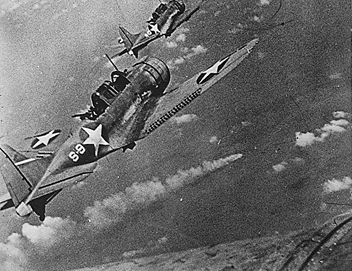
SBD dive bombers arrive over the
Japanese heavy cruiser
MIKUMA (in the middle of the picture, smoking)
Yorktown didn't sink as it was expected. She was found floating right there where they left her. A salvage party was formed, which managed to lessen the degree of list, but on June 6, a submarine, I-168 managed to get through the destroyer screen and put two torpedoes into the Yorktown's starboard side. The USS Yorktown sank at 0458 on July 7, 1942.
Midway cost the Japanese the whole war in the Pacific. From this battle on, Japanese would start losing their supremacy in the Pacific.
Home |
Bio | Pi |
Socrates | Plato |
Aristotle |
Fascinating Facts |
SEO
Clients |
Blog |
Search |
Webmaster |
Contact
|
|